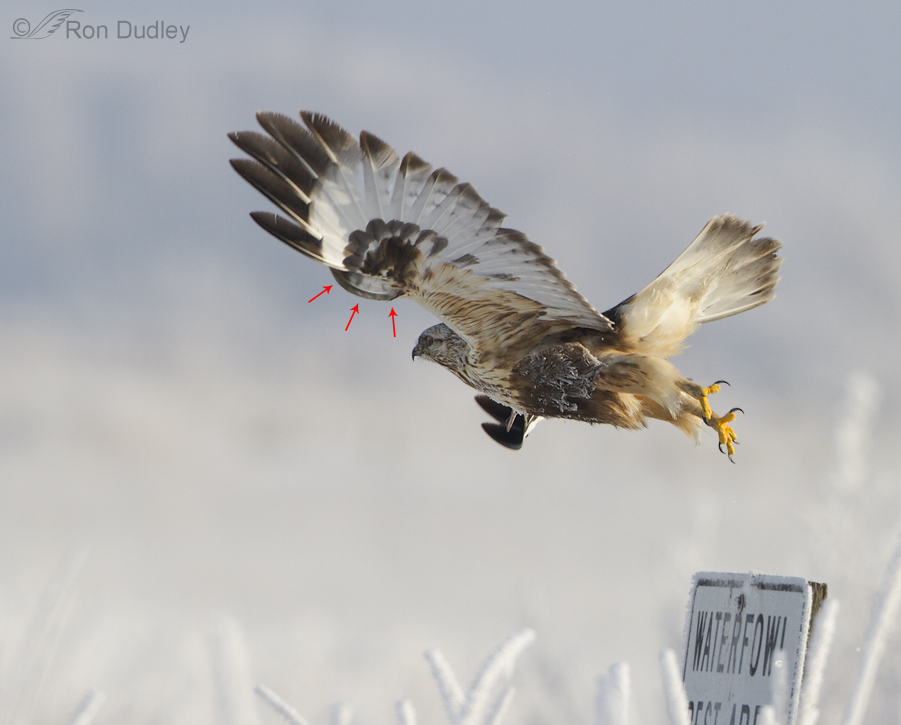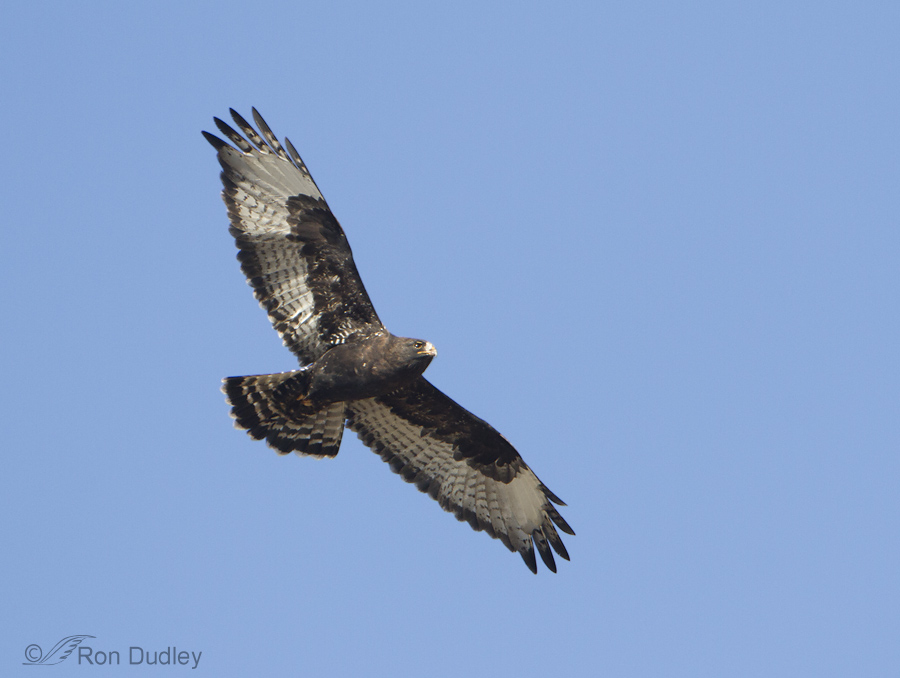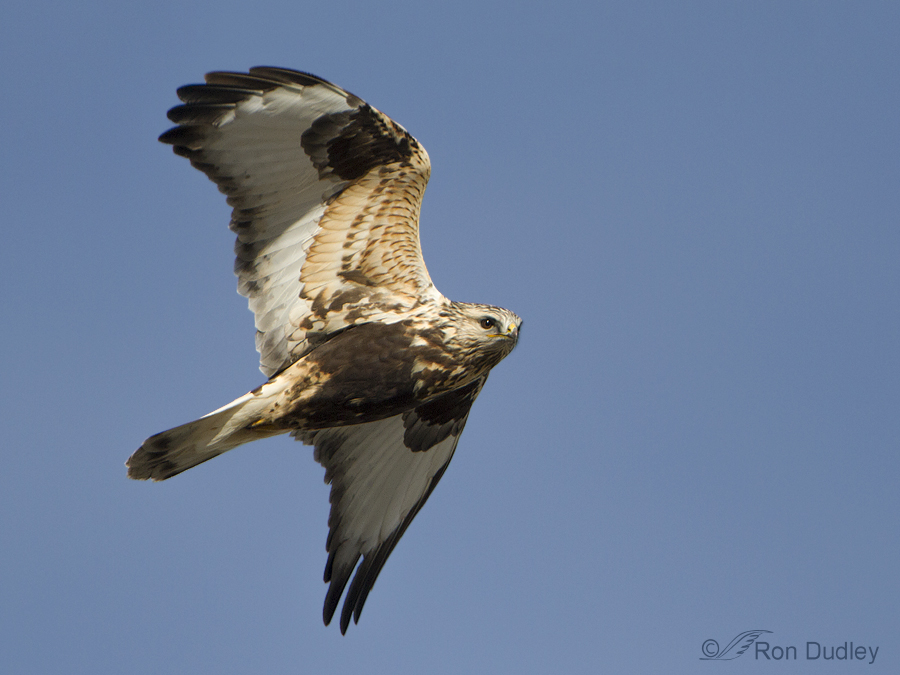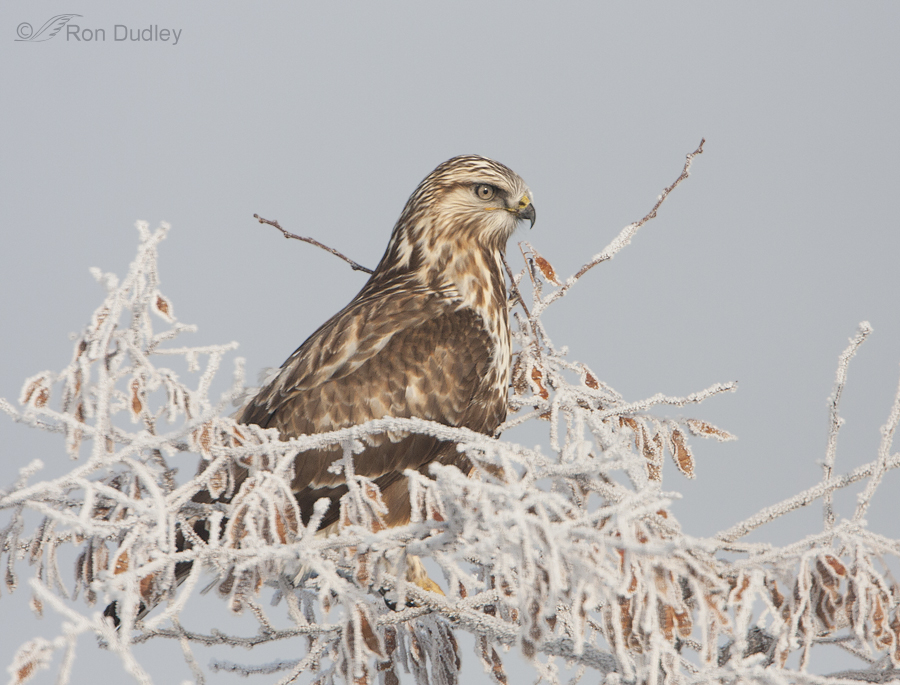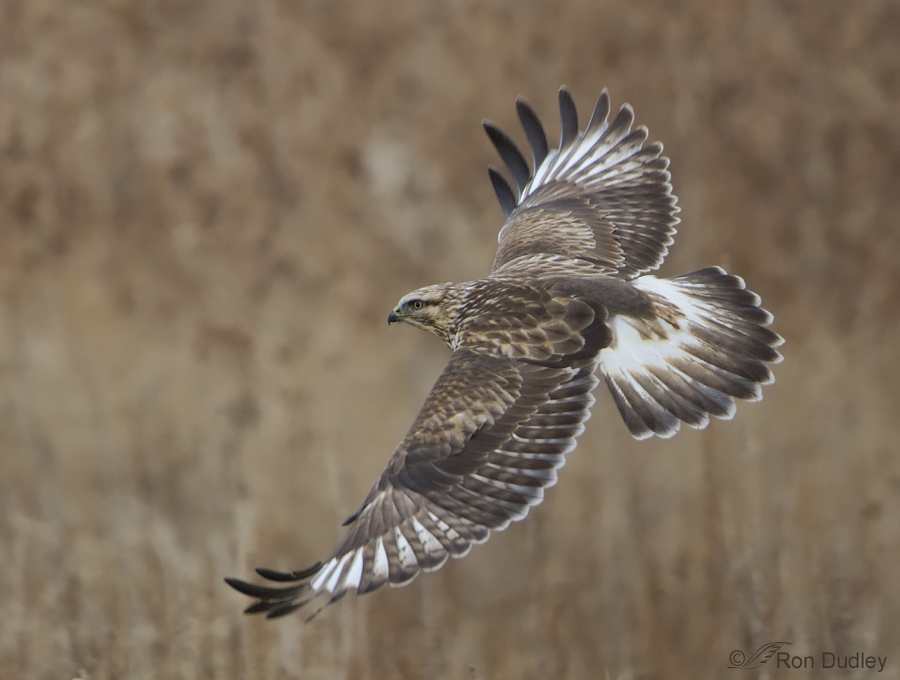Tag: buteo lagopus
Rough-legged Hawk In A Frosty Wonderland
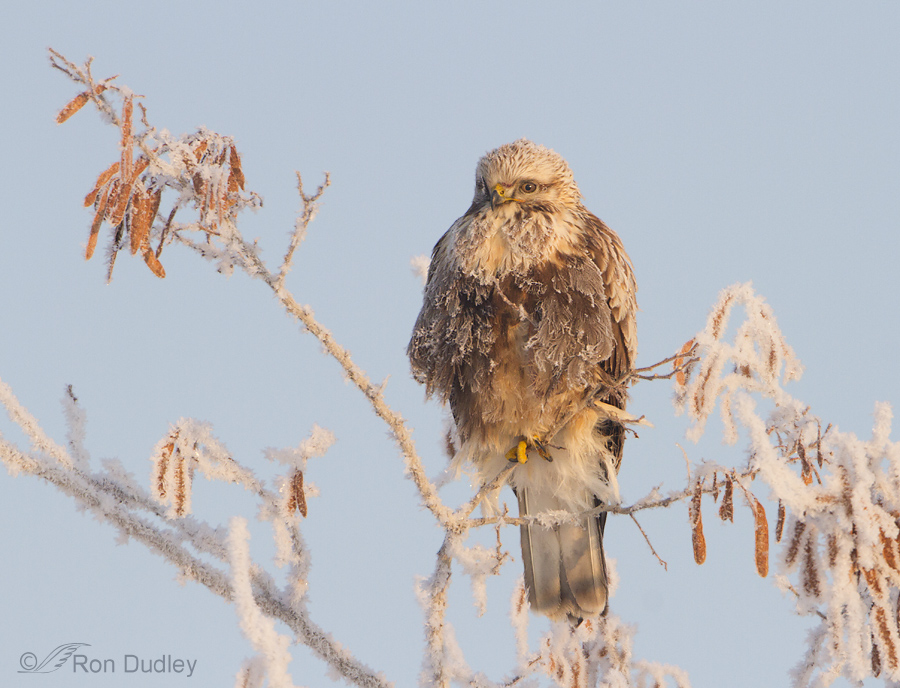
During winter, photography in the valley of the Great Salt Lake can be difficult at best due to frequent inversions that trap fog and smog in the low-lying areas and that especially includes the marshes near the lake. These inversions often last for days or even weeks and the fog and smog get progressively worse each day. But the fortunate result for photographers is the thick hoarfrost that blankets everything in the vicinity of the lake if and when the fog burns off during the day.
Dark Morph Rough-legged Hawk
Rough-legged Hawk Hunting Technique
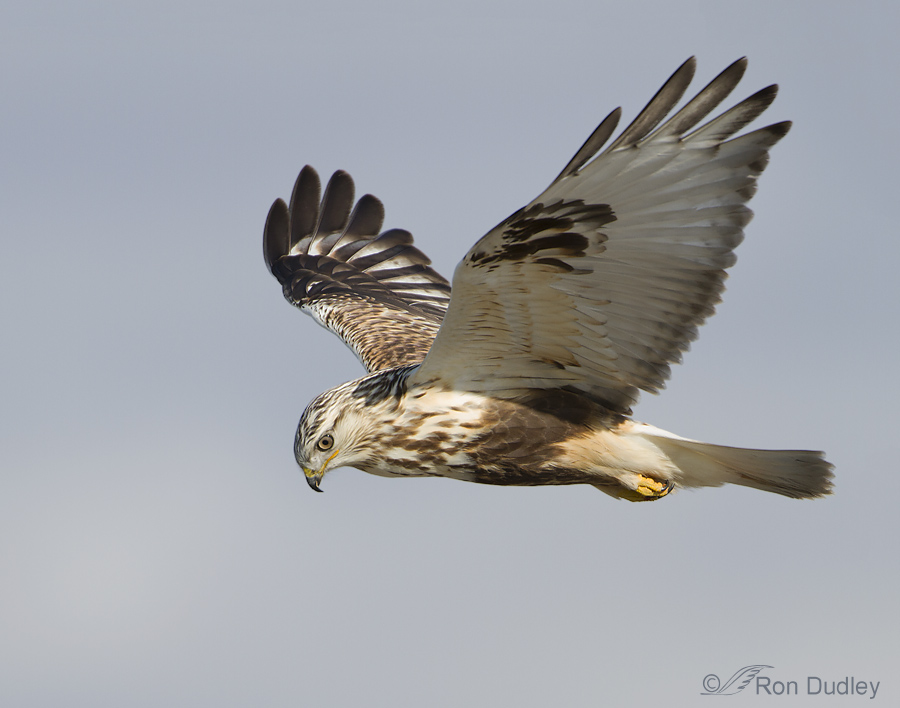
Like some other buteos, depending on conditions the Rough-legged Hawk may hunt from the air using flapping/gliding flight or from an elevated perch but their tendency to hunt in flight goes up significantly with increasing wind speed. This makes sense because hovering in the wind requires less energy than flapping flight.
Rough-legged Hawk Flying Into The Wind
Frosty Rough-legged Hawk
The Roughies Are Coming!
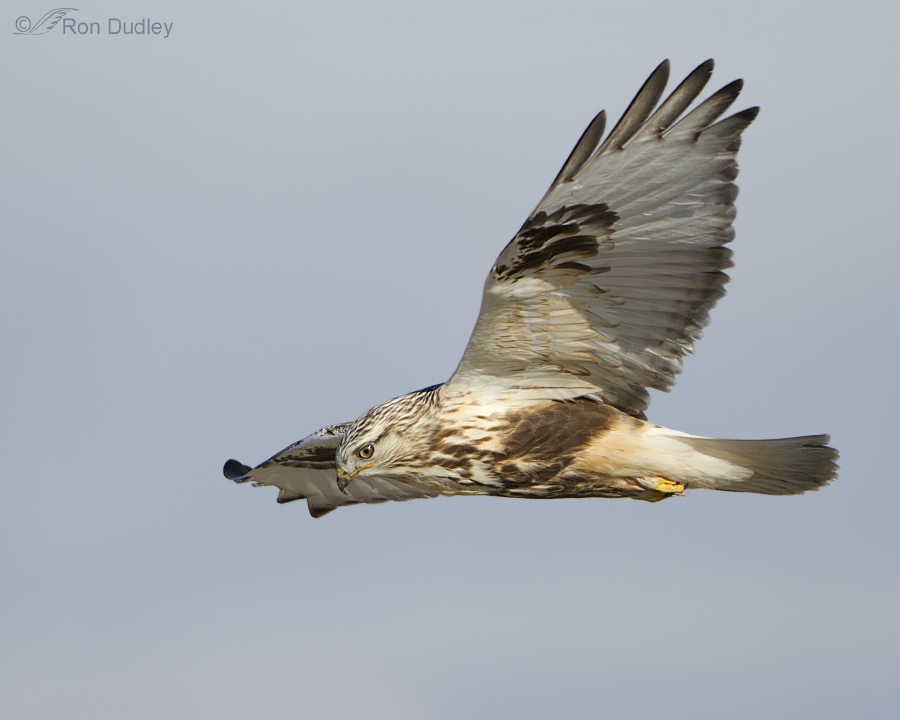
Early this morning, before leaving to look for birds on Antelope Island, I saw a Facebook post by my friend, bird aficionado and artist extraordinaire Bryce Robinson. It was a simple post, saying simply ” “I felt a change in the air today. The Roughies are coming…” and it was illustrated with one of his fine drawings – a portrait of a Rough-legged Hawk. The “change in the air” that Bryce was referring to was our first nippy cold morning after a long, hot summer and such changes always bring thoughts to mind of the return of the Rough-legged Hawk.
Then I spent the morning on the island looking in vain for birds (it’s very slow out there right now) so as I drove around my mind wandered regularly to thoughts of Roughies – inspired by Bryce’s post and the chilly temps (51 degrees on the causeway).
Flaring Rough-legged Hawk
Rough-legged Hawk With A Peculiar Hunting Technique
I’ve spent many hours watching Rough-legged Hawks hunt. Nearly always they hunt from the air or from elevated perches but several years ago this bird showed me a technique I had never seen before and haven’t since. All of these images are presented in the order they were taken. Techs for these shots were: 1/2000 – 1/3200, f/8. ISO 400, 500 f/4, 1.4 tc, natural light, not baited, set up or called in I found the hawk on the ground and as I approached it in my pickup it didn’t fly off as I expected it would. Here it’s looking at me but most of the time it was scanning the grasses in the vicinity – obviously hunting for voles from the ground. It would lift off but only fly a few feet before it landed again. In this first lift-off it had vegetation in its talons. I’ve seen them do this before – it’s almost like they’re reluctant to let go of the plant material after they’ve missed the prey. The hawk landed again… And intensely scanned the surrounding area for prey. Then another take-off… and it flew within inches of the ground… before it pounced on a vole and swallowed it. Then it continued to hunt in the same manner. Another take-off… and another. There’s blood on the right foot from the last vole. The hawk repeatedly did the same thing – take…
Rough-legged Hawk Mantling, Then Take-off
My encounter with this Rough-legged Hawk was a frustrating one. It all began with a Northern Harrier on the snow-covered ground with prey (which turned out to be a Pied-billed Grebe) . It was quite far away, even if my tc had been attached (it wasn’t), so I put my pickup in gear to drive further down the road. Just then this hawk swooped in from behind (I couldn’t see it coming) to pilfer the prey from the harrier. By the time I got the pickup turned off and my tc attached the action between the two raptors was over – the harrier had vamoosed with the head of the grebe (based on the photos Mia was able to get) and the roughie was on the ground with what was left. 1/3200, f/6.3, ISO 500, 500 f/4, 1.4 tc, natural light, not baited, set up or called in Here the hawk is “mantling” the grebe. Mantling is a behavior of raptors where they spread their wings, fan their tail and arch their body over their prey – effectively hiding it from other predators, particularly other raptors. In this image the tail isn’t completely fanned and the bird is looking back at us rather than arching its body. There’s a patch of blood on the snow and you can see part of the grebe under the right wing. 1/5000, f/6.3, ISO 500, 500 f/4, 1.4 tc, natural light, not baited, set up or called in The hawk quickly gobbled down what was left of the grebe, inspected the…
Rough-legged Hawk “Playing”
This post is about behavior. Please don’t expect high quality images… Last March I found this juvenile (I believe) Rough-legged Hawk along the Antelope Island causeway on a cold morning after a light snowfall. It was perched on a windrow of debris consisting mostly of piles of old brine fly pupae casings. For a while the bird seemed content to simply rest and watch me. But soon it apparently got bored… and walked about two feet to my right to investigate a clump of fly casings (red arrow) that had been cemented together by melting snow that had re-frozen during the night. The hawk reached over to grasp the clump with its talons… retrieved the clump,… transferred it to its beak and then instantly tossed it to the ground. I assumed that was that, figuring the bird had thought it might be something edible, then discarded it for good when it wasn’t. But that wasn’t what happened. The hawk grabbed the clump with its talons once again… and then seemed to contemplate for a few seconds about just what to do next. Which turned out to be something like “give the clump a toss and see where it lands”. The hawk immediately started walking over to where the clump had landed behind the mound of fly casings, where it can’t be seen in this image. It used its wings for a little more stability as it negotiated the hill of debris. …
The Return Of The Rough-legged Hawks
One of the most pleasant harbingers of winter for me is always the return of the Rough-legged Hawks. This species breeds in high subarctic and arctic regions so we don’t see them from about March through October but they usually winter around here in good numbers and I love to photograph this handsome buteo. There’s been a few “roughies” on Antelope Island for a couple of weeks now but this morning was the first time this year I’ve been able to get close enough for good photos. This bird chose to perch on the same dark rocks that I’ve been photographing Red-tailed Hawks on. 1/2500, f/7.1, ISO 500, 500 f/4, 1.4 tc, natural light, not baited, set up or called in (same techs for all the images in this post) I wasn’t quite as close as I’d have liked to have been for perched shots so I waited for take-off. And waited. And waited. Almost went to sleep… Finally, a couple of men on horseback were riding the trail behind the rock in the background and I figured they’d spook the bird. They did. At least I didn’t miss the moment of take-off, which is so easy to do when you have to wait for it for so long. I got five sharp shots after take-off and something unusual happened with each of them. Normally, you’re lucky to get one image with the bird looking directly at you. Usually, they’re looking in the direction of flight but for some…
Anticipating The Return Of Rough-legged Hawks
Rough-legged Hawks are a true arctic species, spending about 7 months of the year on their breeding grounds in the arctic or sub-arctic tundra or taiga of Alaska or Canada. Then they migrate south and winter in most of the lower 48 states, with the exception of the SE region and parts of California and Arizona. I love it when they’re here as I find them to be exceedingly handsome birds and I really enjoy photographing them. And yes, I’m already looking forward to their return. Every time I’m in their favorite haunts I can’t help looking for them on some of their preferred perches, even this time of year. So, feeling a little nostalgic for them on a Saturday night, I thought I’d do a post on the species. 1/2000, f/6.3, ISO 500, 500 f/4, 1.4 tc, natural light, not baited, set up or called in Normally I’m not terribly fond of the Tintic Quartzite rocks on Antelope Island as perches because they’re so bright that they tend to blow out the whites but as you can see by the shadows the sun was still very low when this shot was taken so I got pretty good detail on most of the perch. And besides, I like the rounded, weathered look of this particular boulder. I do wish the out of focus sunflower heads in the foreground weren’t there but for me they’re not an image killer. 1/2000, f/7.1, ISO 500, 500 f/4, 1.4 tc, natural light, not baited, set up or called in This is one of…
Rough-legged Hawk Hunting Voles
Out of pure habit I still look for Rough-legged Hawks whenever I pass one of their favorite perches, despite the fact that they’re now on their arctic and subarctic breeding grounds in northern Alaska and Canada. Last winter it seemed that these hawks were everywhere in northern Utah and it wasn’t unusual for me to see a dozen or more different birds in a morning of shooting. They’re a particularly handsome raptor and I love photographing them. 1/3200, f/6.3, ISO 500, 500 f/4, 1.4 tc I found this one hunting voles along the Antelope Island causeway this past December. A moderate headwind slowed the bird down and made getting flight shots a little easier. 1/2500, f/6.3, ISO 500, 500 f/4, 1.4 tc When hunting they’re usually looking down which makes it difficult to get eye contact but occasionally you can catch them looking at you if you’re quick on the trigger. Here the wings are mostly horizontal but for me the tilt of the tail helps to compensate for that. 1/1600, f/6.3, ISO 500, 500 f/4, 1.4 tc This eye/head angle is more typical of a hunting bird. The position of the left wing probably won’t appeal to many but there’s something about the curves of both wings that I liked. The sky color may seem a little funky but that’s the color it really was so I didn’t play with it. 1/1600, f/6.3, ISO 500, 500 f/4, 1.4 tc Here the hawk has captured a baby vole. This surprised me a little…
Rough-legged Hawk on Tamarisk
I’ve said before that for me the Rough-legged Hawk is among the most handsome of North American raptors. 1/2500, f/6.3, ISO 500, 500 f/4, 1.4 tc I found this bird perched on some tamarisk just below an elevated road on Antelope Island and was able to get some shots I like as it lifted off. I’ve posted another image of the sequence here. In late April of this year state park personnel cut down the stand of tamarisk. I fully understand the need to get rid of them because tamarisk is an invasive plant that is widely believed to degrade native wildlife habitat and disrupt the structure and stability of North American native plant communities. That said I will miss them as there aren’t many elevated and attractive natural perches on the island. Ron
Rough-legged Hawk In A Frosty Wonderland

During winter, photography in the valley of the Great Salt Lake can be difficult at best due to frequent inversions that trap fog and smog in the low-lying areas and that especially includes the marshes near the lake. These inversions often last for days or even weeks and the fog and smog get progressively worse each day. But the fortunate result for photographers is the thick hoarfrost that blankets everything in the vicinity of the lake if and when the fog burns off during the day.
Dark Morph Rough-legged Hawk
Rough-legged Hawk Hunting Technique

Like some other buteos, depending on conditions the Rough-legged Hawk may hunt from the air using flapping/gliding flight or from an elevated perch but their tendency to hunt in flight goes up significantly with increasing wind speed. This makes sense because hovering in the wind requires less energy than flapping flight.
Rough-legged Hawk Flying Into The Wind
Frosty Rough-legged Hawk
The Roughies Are Coming!

Early this morning, before leaving to look for birds on Antelope Island, I saw a Facebook post by my friend, bird aficionado and artist extraordinaire Bryce Robinson. It was a simple post, saying simply ” “I felt a change in the air today. The Roughies are coming…” and it was illustrated with one of his fine drawings – a portrait of a Rough-legged Hawk. The “change in the air” that Bryce was referring to was our first nippy cold morning after a long, hot summer and such changes always bring thoughts to mind of the return of the Rough-legged Hawk.
Then I spent the morning on the island looking in vain for birds (it’s very slow out there right now) so as I drove around my mind wandered regularly to thoughts of Roughies – inspired by Bryce’s post and the chilly temps (51 degrees on the causeway).
Flaring Rough-legged Hawk
Rough-legged Hawk With A Peculiar Hunting Technique
I’ve spent many hours watching Rough-legged Hawks hunt. Nearly always they hunt from the air or from elevated perches but several years ago this bird showed me a technique I had never seen before and haven’t since. All of these images are presented in the order they were taken. Techs for these shots were: 1/2000 – 1/3200, f/8. ISO 400, 500 f/4, 1.4 tc, natural light, not baited, set up or called in I found the hawk on the ground and as I approached it in my pickup it didn’t fly off as I expected it would. Here it’s looking at me but most of the time it was scanning the grasses in the vicinity – obviously hunting for voles from the ground. It would lift off but only fly a few feet before it landed again. In this first lift-off it had vegetation in its talons. I’ve seen them do this before – it’s almost like they’re reluctant to let go of the plant material after they’ve missed the prey. The hawk landed again… And intensely scanned the surrounding area for prey. Then another take-off… and it flew within inches of the ground… before it pounced on a vole and swallowed it. Then it continued to hunt in the same manner. Another take-off… and another. There’s blood on the right foot from the last vole. The hawk repeatedly did the same thing – take…
Rough-legged Hawk Mantling, Then Take-off
My encounter with this Rough-legged Hawk was a frustrating one. It all began with a Northern Harrier on the snow-covered ground with prey (which turned out to be a Pied-billed Grebe) . It was quite far away, even if my tc had been attached (it wasn’t), so I put my pickup in gear to drive further down the road. Just then this hawk swooped in from behind (I couldn’t see it coming) to pilfer the prey from the harrier. By the time I got the pickup turned off and my tc attached the action between the two raptors was over – the harrier had vamoosed with the head of the grebe (based on the photos Mia was able to get) and the roughie was on the ground with what was left. 1/3200, f/6.3, ISO 500, 500 f/4, 1.4 tc, natural light, not baited, set up or called in Here the hawk is “mantling” the grebe. Mantling is a behavior of raptors where they spread their wings, fan their tail and arch their body over their prey – effectively hiding it from other predators, particularly other raptors. In this image the tail isn’t completely fanned and the bird is looking back at us rather than arching its body. There’s a patch of blood on the snow and you can see part of the grebe under the right wing. 1/5000, f/6.3, ISO 500, 500 f/4, 1.4 tc, natural light, not baited, set up or called in The hawk quickly gobbled down what was left of the grebe, inspected the…
Rough-legged Hawk “Playing”
This post is about behavior. Please don’t expect high quality images… Last March I found this juvenile (I believe) Rough-legged Hawk along the Antelope Island causeway on a cold morning after a light snowfall. It was perched on a windrow of debris consisting mostly of piles of old brine fly pupae casings. For a while the bird seemed content to simply rest and watch me. But soon it apparently got bored… and walked about two feet to my right to investigate a clump of fly casings (red arrow) that had been cemented together by melting snow that had re-frozen during the night. The hawk reached over to grasp the clump with its talons… retrieved the clump,… transferred it to its beak and then instantly tossed it to the ground. I assumed that was that, figuring the bird had thought it might be something edible, then discarded it for good when it wasn’t. But that wasn’t what happened. The hawk grabbed the clump with its talons once again… and then seemed to contemplate for a few seconds about just what to do next. Which turned out to be something like “give the clump a toss and see where it lands”. The hawk immediately started walking over to where the clump had landed behind the mound of fly casings, where it can’t be seen in this image. It used its wings for a little more stability as it negotiated the hill of debris. …
The Return Of The Rough-legged Hawks
One of the most pleasant harbingers of winter for me is always the return of the Rough-legged Hawks. This species breeds in high subarctic and arctic regions so we don’t see them from about March through October but they usually winter around here in good numbers and I love to photograph this handsome buteo. There’s been a few “roughies” on Antelope Island for a couple of weeks now but this morning was the first time this year I’ve been able to get close enough for good photos. This bird chose to perch on the same dark rocks that I’ve been photographing Red-tailed Hawks on. 1/2500, f/7.1, ISO 500, 500 f/4, 1.4 tc, natural light, not baited, set up or called in (same techs for all the images in this post) I wasn’t quite as close as I’d have liked to have been for perched shots so I waited for take-off. And waited. And waited. Almost went to sleep… Finally, a couple of men on horseback were riding the trail behind the rock in the background and I figured they’d spook the bird. They did. At least I didn’t miss the moment of take-off, which is so easy to do when you have to wait for it for so long. I got five sharp shots after take-off and something unusual happened with each of them. Normally, you’re lucky to get one image with the bird looking directly at you. Usually, they’re looking in the direction of flight but for some…
Anticipating The Return Of Rough-legged Hawks
Rough-legged Hawks are a true arctic species, spending about 7 months of the year on their breeding grounds in the arctic or sub-arctic tundra or taiga of Alaska or Canada. Then they migrate south and winter in most of the lower 48 states, with the exception of the SE region and parts of California and Arizona. I love it when they’re here as I find them to be exceedingly handsome birds and I really enjoy photographing them. And yes, I’m already looking forward to their return. Every time I’m in their favorite haunts I can’t help looking for them on some of their preferred perches, even this time of year. So, feeling a little nostalgic for them on a Saturday night, I thought I’d do a post on the species. 1/2000, f/6.3, ISO 500, 500 f/4, 1.4 tc, natural light, not baited, set up or called in Normally I’m not terribly fond of the Tintic Quartzite rocks on Antelope Island as perches because they’re so bright that they tend to blow out the whites but as you can see by the shadows the sun was still very low when this shot was taken so I got pretty good detail on most of the perch. And besides, I like the rounded, weathered look of this particular boulder. I do wish the out of focus sunflower heads in the foreground weren’t there but for me they’re not an image killer. 1/2000, f/7.1, ISO 500, 500 f/4, 1.4 tc, natural light, not baited, set up or called in This is one of…
Rough-legged Hawk Hunting Voles
Out of pure habit I still look for Rough-legged Hawks whenever I pass one of their favorite perches, despite the fact that they’re now on their arctic and subarctic breeding grounds in northern Alaska and Canada. Last winter it seemed that these hawks were everywhere in northern Utah and it wasn’t unusual for me to see a dozen or more different birds in a morning of shooting. They’re a particularly handsome raptor and I love photographing them. 1/3200, f/6.3, ISO 500, 500 f/4, 1.4 tc I found this one hunting voles along the Antelope Island causeway this past December. A moderate headwind slowed the bird down and made getting flight shots a little easier. 1/2500, f/6.3, ISO 500, 500 f/4, 1.4 tc When hunting they’re usually looking down which makes it difficult to get eye contact but occasionally you can catch them looking at you if you’re quick on the trigger. Here the wings are mostly horizontal but for me the tilt of the tail helps to compensate for that. 1/1600, f/6.3, ISO 500, 500 f/4, 1.4 tc This eye/head angle is more typical of a hunting bird. The position of the left wing probably won’t appeal to many but there’s something about the curves of both wings that I liked. The sky color may seem a little funky but that’s the color it really was so I didn’t play with it. 1/1600, f/6.3, ISO 500, 500 f/4, 1.4 tc Here the hawk has captured a baby vole. This surprised me a little…
Rough-legged Hawk on Tamarisk
I’ve said before that for me the Rough-legged Hawk is among the most handsome of North American raptors. 1/2500, f/6.3, ISO 500, 500 f/4, 1.4 tc I found this bird perched on some tamarisk just below an elevated road on Antelope Island and was able to get some shots I like as it lifted off. I’ve posted another image of the sequence here. In late April of this year state park personnel cut down the stand of tamarisk. I fully understand the need to get rid of them because tamarisk is an invasive plant that is widely believed to degrade native wildlife habitat and disrupt the structure and stability of North American native plant communities. That said I will miss them as there aren’t many elevated and attractive natural perches on the island. Ron


